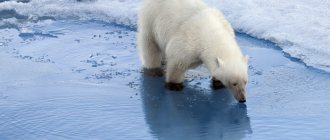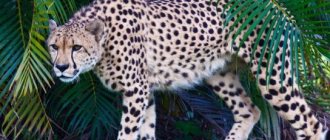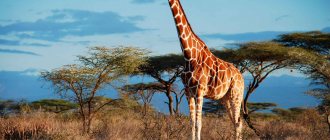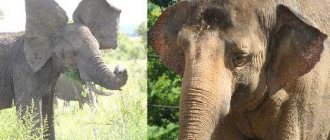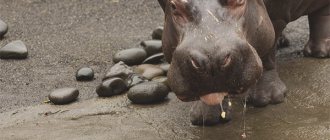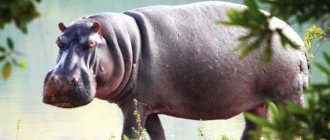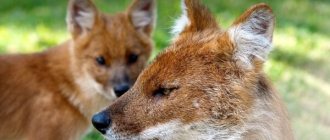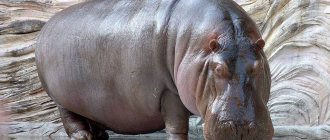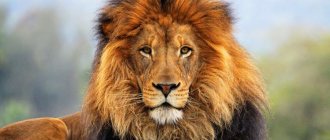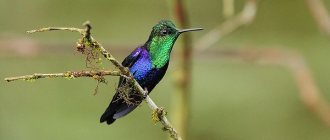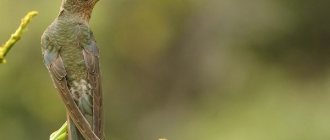Few animals capture the human imagination as much as the brown bear. They are priority inhabitants of the animal world, which are so necessary to preserve. Given their dependence on large territorial areas, brown bears are an important part of the control of a number of other animals.
The brown bear is one of the largest predators among animals. On average, adult males are 8-10% larger than females, but sizes vary depending on the species' habitat. Brown bears feed in the morning and evening, and during the daytime they prefer to rest under dense vegetation. Depending on the time of year, brown bears can travel hundreds of kilometers to search for food.
Hibernation
Hibernation lasts from October-December to March-May. In some southern regions, the duration of hibernation is very short or completely absent. The brown bear chooses a place for itself, for example, a hole, which is located on a protected slope under a large stone or among the roots of a large tree. The same hibernation sites can be used for many years.
How to stimulate hunters
Young animals go to populated areas much more often than adults. According to Morgunov, in this regard, monitoring and control measures are needed in nearby areas: it is necessary to monitor the population and regulate the number in these areas as much as possible. “For example, in the Vologda region, to prevent road accidents, the issuance of permits [for hunting animals] along federal highways was widespread. This creates a vacuum for a certain moment, then it is filled. But if we constantly carry out these activities, we will minimize the number of conflict situations,” he noted.
In order for hunters to hunt brown bears and wolves, different incentive methods are used in different regions. In the Vologda region, for two adult wolves killed, a permit to hunt elk is given. There are monetary compensations. In 2022, the Komi Republic began paying 20 thousand rubles for a hunted bear or wolf. “There was interest; for a rural resident, 20 thousand minus income tax is significant. Many unemployed people <...> got busy, but not everyone has enough qualifications, but people are learning, and if you support them for several years, then this is a strong help,” Pavlov noted. At the end of 2022, hunters were paid about 3 million rubles. This support measure is planned to be extended in 2020.
The frequency of animals approaching populated areas and entering cities and towns has become more frequent. As Morgunov noted, it is necessary to solve the problem of how to return animals that have ended up there from populated areas back to the forest. Moreover, this applies not only to predators, but, for example, moose. “Bringing a large animal out of Vologda or Yaroslavl can be problematic. It enters the territory at night, passes through park areas while there are no cars or people, and is located in a densely populated area. If you simply chase it, the animal will run straight ahead, and a positive result is not always obtained; injuries are caused to the population. Or the animal itself is injured and dies,” he said. According to the agency's interlocutor, the most effective way is to immobilize the animal with special drugs. But these technologies must be developed. “In addition to hunting control employees, veterinarians must be involved, who must monitor the condition of the animal, what dosage of the drug needs to be provided in order to carry out activities efficiently,” he added.
Life cycle
Newborn bears are vulnerable because they are born blind, without hair, and weighing only 340-680 grams. The cubs grow very quickly and reach 25 kilograms at 6 months. The lactation period lasts 18-30 months. The cubs usually remain with their mother until their third or fourth year of life. Despite the fact that sexual maturity occurs at 4-6 years, the brown bear continues to grow and develop until 10-11 years. In the wild they can live from 20 to 30 years, but despite this life expectancy, most die at an early age.
In defense of the wild beast
“The Federal Security Service of Russia has developed a draft decree of the Russian government, according to which it proposes to recognize all populations of brown and Himalayan bears as a strategically important resource.”
And even though today they are not considered rare species of animals, their skins are used as carpets for walls or floors, paws as ashtrays, claws and teeth as decorations, bile as medicine. These goods are in high demand on underground foreign markets, which leads to illegal hunting.
Interesting! How much is shark oil sold for in different countries?
The FSB’s proposal is supported by the Ministry of Natural Resources as capable of establishing special measures to protect bears and preserve their population amid growing demand on the illegal market.
“Illegal trade... occurs in very large volumes, and although it does not yet threaten the existence of species, it requires the intervention of authorities. We can approve any measures that will lead to tougher punishment for poaching and smuggling of these animal species” (M. Kreindlin, Greenpeace Russia expert).
But things didn’t go beyond the proposal. It turns out that the number of bears is growing fast enough that its population is in danger of extinction. In the meantime, the court and the case, fines for illegal hunting have increased several times. And annually, quotas for hunting animals during the hunting season in the regions are approved and monitored by local authorities.
Haven’t you counted how many bears died in fires in the Krasnoyarsk Territory? Maybe there is no need to shoot specifically?
— Lyudmila Kameneva (@milakamenewa) August 4, 2019
Author: Demidova Marina. February 8, 2022.
Nutrition
Brown bears are omnivores, and their diet varies depending on the time of year - from grass in the spring, berries and apples in the summer, to nuts and plums in the fall. Throughout the year, they feed on roots, insects, mammals (including moose and wapiti from the Canadian Rockies), reptiles and, of course, honey. In Alaska, during the summer, bears feed on salmon going to spawn.
White bears
As Ivan Agapitov, deputy head of the department of natural resources and ecology of the department of natural resources, ecology and agro-industrial complex of the Nenets Autonomous Okrug, told TASS, the number of approaches to populated areas of polar bears, which are listed in the Red Book, has increased in the region. In 2022, bears came to the villages seven times, in 2022 - 12 times, in 2022 - 10 times, and the predators began to move far from the sea, where they usually hunt seals from the ice. In 2022, the bear spent a month near objects in the Trebs and Titov oil fields, inland. “He was at oil production facilities for a month, he was monitored, and in some cases he was driven away. And after some time he left. There has been no information about him since February 20,” Agapitov said, explaining that in this case the oil workers acted correctly, scaring off the animal.
The region has developed a procedure for what to do if a polar bear approaches a populated area; a special reminder has been made, which is now used by residents not only of populated areas in the east of the region and the islands, but also by oil workers. “We also give advice to oil workers: first of all, do not approach, try to scare them away and prevent baiting - the most important thing. The first priority is to try to drive away the bear, to show that there is nothing for him to do here, that he will not find food here, and so that he continues on his own path,” the agency’s interlocutor noted, adding that in all cases the bears were scared away.
Only once, in 2014, a predator had to be euthanized and taken away by helicopter because the animal had been fed. “The bear entered oil production facilities, there was a direct violation there, the bear was fed, it had a separate allowance. He was taken away twice. The first time they took him to Dolgiy Island, a day later he returned back to the canteen, then he was taken to the north of Vaygach Island, he never returned,” he said.
According to Agapitov, bears have begun to approach populated areas more often due to climate change. “Most likely, this is global warming, bears are more on the mainland, they have to look for food in populated areas. Again, this is a migratory species and along its route it comes across populated areas,” he noted, explaining that polar bears most often approach housing in August and autumn, until fast ice has formed on the sea, from which predators can hunt.
Population and distribution
The total population of brown bears on the planet is about 200,000 individuals, with Russia home to the largest number - close to 100,000 individuals.
Scientists believe that 8,000 brown bears live in Western Europe (Slovakia, Poland, Ukraine, Romania). There are also suggestions that the species can be found in Palestine, Eastern Siberia and the Himalayan regions. Possible habitats are considered to be the Atlas Mountains in northwestern Africa and the island of Hokkaido, located in Japan.
Brown bears are still quite common in the mountainous regions of western Canada and Alaska, where their numbers can reach 30,000 individuals. There are fewer than 1,000 brown bears left in other parts of the United States.
White-breasted or Himalayan
This animal is quite rare. And it has several names:
- white breast;
- Asiatic;
- Tibetan;
- Himalayan;
- lunar;
- Ussuri.
Source: My Geography
The population of this species cannot boast of hundreds of thousands of individuals. And it is found in the Russian Federation only in three regions of the Far Eastern Federal District. At the end of 2022, there were only 7.8 thousand hunting objects:
- 4,460 of them in the Primorsky Territory;
- 3,150 – in Khabarovsk;
- 235 – in the Jewish Autonomous Region.
They exist in the Amur region, but are listed in the regional Red Book.
Licensed hunting of this animal was either banned or revived again. But it always remains very limited and expensive.
Table 3. Prey of white-breasted bears
| Season | Individuals |
| 2013-2014 | 84 |
| 2014-2015 | 145 |
| 2015-2016 | 137 |
| 2016-2017 | 143 |
| 2017-2018 | 178 |
Source: Ministry of Natural Resources
Some features of the ecology, biology and morphology of the Kamchatka bear
- The Kamchatka brown bear has no enemies in its natural habitat, because... this species is at the top of the food pyramid. Occasionally, a wolf pack can successfully hunt a young or weakened bear. Some brown bears kill and eat each other.
- A brown bear grows and increases in mass throughout its life. And especially intensively until the age of 9-12, living in the wild until the age of 25-35 years and in captivity - up to 40 years. But the age of an animal and its size are not always directly related. Thus, in the spring of 1998, a 34-year-old male was caught in the north of the region; his weight did not exceed 200 kg.
- Sexual dimorphism in Kamchatka bears is weakly expressed: although on average females are smaller and lighter than males by about a third, this is far from the rule. Very large female bears are often found - they are called “mothers”, which outwardly differ little from males and are not inferior to them in size.
- Brown bears have more than just brown fur . Their fur color varies widely: from very light, sandy and straw to dark brown tones; There are also almost black animals. The cubs of the first year of life have white “collars” or “ties”.
- The front paws of a brown bear are a very powerful weapon and tool used for defense and attack, catching salmon, digging dens and plant roots, extracting gophers, marmots and hay stands from under stones, turning over fallen trees in search of invertebrates, etc. The size of the claws is impressive - on the front paws they are much longer than on the hind paws, and the bend can reach 12-13 cm. The claws of bears can be light, brown and black in different shades.
From the prints of the front paws (or plantar calluses) one can judge the size (very approximately) and the age of the animal. In bear cubs of the current year of birth, the width of the plantar callus is on average 7-8 cm, in bear cubs of the second year of life - 10-12 cm, in adult female bears - 14-17 cm, in adult males - 17-24 cm or more.
- Bears reach sexual maturity in the fifth or sixth year of life . The most productive animals are in the age range from 5-6 to 12 years.
- Kamchatka brown bears have a fairly low reproduction rate. During her life, one female bear gives birth to an average of 12-15 cubs , of which less than half survive to the age of puberty. Low reproduction rates are one of the reasons for the vulnerability of the brown bear as a species.
- The breeding season for bears occurs mainly in May-June. At this time, bears form “mating groups” or “mating pairs”, which can break up and form with other partners. Males are aggressive and dangerous at this time. Taking into account the peculiarities of biology and the change of “marriage” partners, a female bear may have cubs from different males in one litter. After mating, the fertilized egg begins to grow, but then the brown bear embryo is delayed in its development. More details>>>
- Bears are the only mammals whose offspring appear during winter sleep. In January-February, a female bear gives birth to cubs, each weighing no more than 0.3-0.6 kg (or no more than 0.2% of the mother’s weight). After all, they live for 3-4 months, and in the conditions of Kamchatka for 5-6 months, they live only on their mother’s milk. More details>>>
- She-bears in Kamchatka give birth to 1-3 (sometimes 4) cubs once every three to four years. Bears are very caring mothers. In Kamchatka, bear cubs are under the care of their mother until the age of 2.5-3.5 years, sometimes up to 4.5 years. The cubs of the first year of life are called “fingerlings”, the second year of life are called “lonchaks”, the third year are called “tretyaks”.
- Little bear cubs are very vulnerable : they are afraid of hypothermia, susceptible to disease and simply injury. About 15% of cubs die in the first year of life, without even having time to spend their first denning period, and more than 25% die by the age of the cubs. The main cause of mortality is cannibalism . A female who has lost her cubs in the spring (including as a result of an attack by a male) again takes part in the rut.
- The lager period, or hibernation , is one of the most remarkable physiological (and behavioral) adaptations. In winter, in Kamchatka, it is impossible for such a large animal as a brown bear to feed itself - and the animals make dens. As a rule, females with cubs of the year are the first to settle (approximately from the beginning - mid-October), then pregnant females and young solitary animals. Adult males, especially dominant ones, can roam the spawning grounds until December. In the den, bears do not eat or drink, they do not defecate or urinate, although metabolic processes, albeit slowly, continue. More details>>>
- Bears are not lumps at all, but very dexterous animals. Both well-fed and small animals can quickly reach speeds of up to 60 km/h. They can climb rocks, narrow and slippery sheep trails and trees. It is believed that only young animals (up to 4-5 years old) can climb trees. Then, as their mass increases, it becomes difficult for bears to climb a tree. But there are facts confirming that even fairly large animals can climb powerful trees without problems.
Adult brown bears are not afraid of hypothermia; on the contrary, they overheat very quickly. Therefore, they love water and go out onto the snowfields to protect themselves from bloodsuckers. Brown bears are excellent swimmers and divers . When searching for spawning salmon, the bear lowers its muzzle into the water and spends hours “scanning” the bottom of the reservoir, picking up fish from the bottom. You have to dive for some fish. There are known cases of brown bears crossing the First Kuril Strait by swimming*.
Reproduction
Exactly after 6-8 months, cubs are born in the den. Usually the female brings 2-4 cubs, completely bald, with underdeveloped organs of hearing and vision. However, after a month, the cubs’ eyes open and the ability to catch sounds appears. Immediately after birth, the cubs weigh about 500 g and their length reaches 25 cm. By 3 months, all baby teeth have erupted in the cubs.
For the first 6 months of their lives, babies feed on mother's milk. Then berries, insects, and greens are added to their diet. Later, the mother brings them fish or her catch. For about 2 years, babies live with their mother, learn habits, the intricacies of hunting, and hibernate with her. The independent life of a young bear begins at the age of 3-4 years. The father bear never takes part in raising his offspring.
Behavior
The bear has very developed sense of smell. He clearly feels the smell of decomposed meat, even being 3 km away from it. His hearing is also very well developed. Sometimes the bear stands on its hind legs to listen to a sound or sense the direction of the smell of food.
How does a bear behave in nature? The brown “master of the taiga” begins to walk around his property at dusk or early in the morning. In bad weather or during rainy periods, he can wander through the forest all day in search of food.
Brown bear: description of appearance
This animal is very strong. The powerful body is covered with thick hair, and the withers are clearly visible on the back. It contains a large number of muscles that allow the bear to deliver crushing blows with its paws, fell trees or dig the ground.
His head is very large, with small ears and small, deep-set eyes. The bears' tail is short - about 2 cm, barely noticeable under the layer of fur. The paws are very strong, with large curved claws reaching a length of 10 cm. When walking, the bear evenly transfers the weight of the body on the entire sole, like a person, and therefore it belongs to the species of plantigrade animals.
The fur of the famous “master of the taiga” is very beautiful - thick, evenly colored. Brown bears have a tendency to shed - in spring and autumn they renew their fur coat. The first coat change occurs immediately after hibernation and is very intense. Its manifestations are especially noticeable during the rutting period. Autumn molting proceeds slowly and continues until hibernation.
